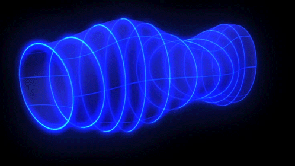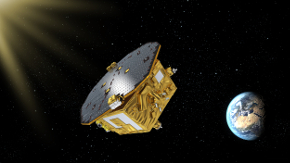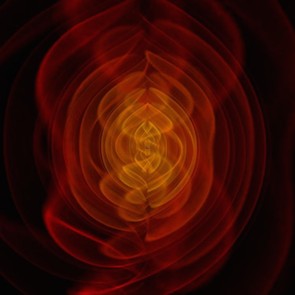ESA congratulations on gravitational wave discovery
11 February 2016
ESA is thrilled to learn that gravitational waves have been detected, and is looking forward to starting its mission to test technologies that could extend the study of these exotic waves to space.
 |
| Gravitational waves. Credit: ESA-C. Carreau |
Gravitational waves are elusive no more: an exciting breakthrough that has been 100 years in the making.
In November 1915, Albert Einstein presented his general theory of relativity, introducing a dramatic change of perspective in the physical understanding of one of the four fundamental interactions of nature: gravity.
This theory describes gravity as the way matter interacts with the flexible 'spacetime' it is embedded in. Massive bodies deform spacetime, changing its curvature as they move.
When accelerated, massive bodies produce tiny fluctuations in the fabric of spacetime – gravitational waves – which were first predicted in a further study published by Einstein in 1918. These minuscule cosmic perturbations have finally been revealed, after almost a century of theoretical investigations and experimental searches.
The discovery was announced today by scientists from the Laser Interferometer Gravitational-Wave Observatory (LIGO) collaboration.
LIGO comprises two gravitational wave detectors in Livingston, Louisiana and Hanford, Washington, USA, and involves over a thousand scientists from across the world.
The experiment uses laser beams to monitor two perpendicular arms, each extending 4 km, to look for tiny changes in their length that might be caused by passing gravitational waves.
Recently upgraded to become Advanced LIGO, the experiment obtained this historic result during the first observation run in the new configuration, which collected data between September 2015 and January 2016.
 |
| Artist's impression of LISA Pathfinder in space. Credit: ESA-C. Carreau |
"This is tremendous news for everyone studying gravity and general relativity, and we send our warmest congratulations to colleagues in the LIGO collaboration for their outstanding result," says Paul McNamara, LISA Pathfinder project scientist at ESA.
LISA Pathfinder is ESA's technology demonstration mission for possible future missions to observe gravitational waves from space. Launched on 3 December 2015, the spacecraft reached its operational orbit in January and is undergoing final checks before starting its science mission on 1 March.
"With LISA Pathfinder, we will be testing the underlying technology to observe gravitational waves from space, and it is even more encouraging to know that these long-mysterious fluctuations have now been directly detected," adds Paul.
A first, indirect confirmation that gravitational waves exist came in the late 1970s, with observations of a pair of neutron stars – the dead cores of massive stars – rapidly orbiting each other.
One of the two neutron stars appears as a pulsating radio source, or pulsar, which allowed precise timing measurements of the system. As the two stellar remnants circle each other, scientists noticed that they move into tighter and faster orbits, and the rate of acceleration was just as it was expected if they were to lose energy by emitting gravitational waves.
But today's announcement by the LIGO collaboration provides the direct detection of gravitational waves that scientists had been seeking for decades.
"Hats off to the LIGO collaboration for their remarkable achievement, having mastered the experimental facilities to reach the exquisite sensitivity required to detect gravitational waves from ground," says César García Marirrodriga, ESA's LISA Pathfinder project manager.
 |
| Simulation of black hole merger. Credit: NASA/C. Henze |
The recorded signal is very strong, and it appears to come from a pair of coalescing black holes about 1.3 billion light-years away. The two monstrous bodies, with masses equivalent to 36 and 29 times the mass of the Sun, respectively, merged to form a single, even more gigantic black hole of 62 solar masses, releasing the remaining 3 solar masses in gravitational waves.
"Now that gravitational waves have been found, we can start delving into the physics of their sources. That's where the move to space will make the difference," says Oliver Jennrich, LISA Pathfinder deputy project scientist at ESA.
Like light, gravitational waves also span a broad spectrum of frequencies, and different astronomical objects are expected to emit these waves all across the spectrum. Ground-based experiments like LIGO are sensitive to high-frequency waves, like those coming from coalescing pairs of black holes or neutron stars, with frequencies of 10–1000 Hz.
To detect gravitational waves with lower frequencies, such as those from the merging of supermassive black holes at the centre of massive galaxies, scientists need to investigate changes in length of much longer arms – about one million kilometres. This can only be achieved in space, using laser beams to monitor the distance between three freely falling masses separated by much larger distances than can be achieved on Earth.
ESA has identified the gravitational Universe as the scientific theme for its L3 mission, the third Large-class mission in the Cosmic Vision science programme, resulting in a large gravitational wave observatory in space in the coming years.
Today's LISA Pathfinder is a step towards L3, because it will test whether it is possible to put test masses in pure free fall, unperturbed by any external forces, at the level needed for the future space-based gravitational wave observatory.
On 3 February, the two masses at the heart of the spacecraft – a pair of identical gold-platinum cubes, 46 mm on each side – were unlocked from one of the two mechanisms that kept them secure during launch and cruise.
The final release will take place next week, leaving the two cubes with no physical contact with the spacecraft, ahead of the start of science operations.
To compensate for other forces acting on the cubes, LISA Pathfinder will measure their position and orientation to exquisite accuracy and manoeuvre itself by tiny amounts to remain centred on one of them.
"LISA Pathfinder has a challenging task ahead, and we are honoured to contribute to this new era of gravitational wave research inaugurated today by the LIGO discovery," concludes Paul.
Notes for Editors
The Laser Interferometer Gravitational-Wave Observatory (LIGO) consists of two widely separated installations within the United States –one in Hanford, Washington and the other in Livingston, Louisiana– operated in unison as a single observatory. LIGO is operated by the LIGO Laboratory, a consortium of the California Institute of Technology (Caltech) and the Massachusetts Institute of Technology (MIT), funded by the National Science Foundation, with significant contributions from other U.S. and international partners. Research and analysis of data from the detectors is carried out by a global group of scientists, including the LIGO Scientific Collaboration, which includes the GEO600 Collaboration, based near Hannover, Germany, and the VIRGO Collaboration, based near Pisa, Italy.
For further information, please contact:
Paul McNamara
LISA Pathfinder Project Scientist
Scientific Support Office
Directorate of Science
European Space Agency
Email: paul.mcnamara![]() esa.int
esa.int
Phone: +31 71 565 8239
César García Marirrodriga
LISA Pathfinder Project Manager
Projects Department
Directorate of Science
European Space Agency
Email: cesar.garcia![]() esa.int
esa.int
Tel: +31 71 565 5172
Oliver Jennrich
LISA Pathfinder Deputy Mission Scientist and L3 mission Study Scientist
Scientific Support Office
Directorate of Science
European Space Agency
Email: oliver.jennrich![]() esa.int
esa.int
Phone: +31 71 565 6074



